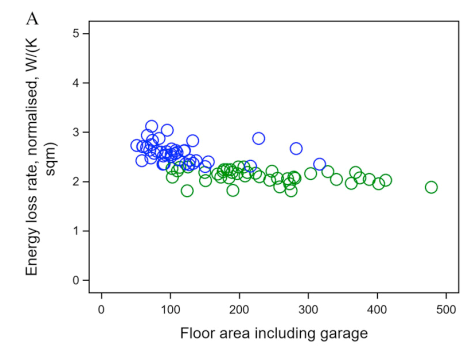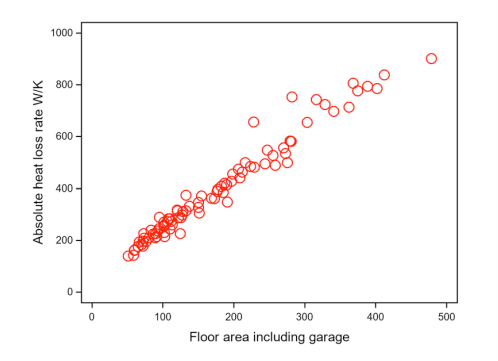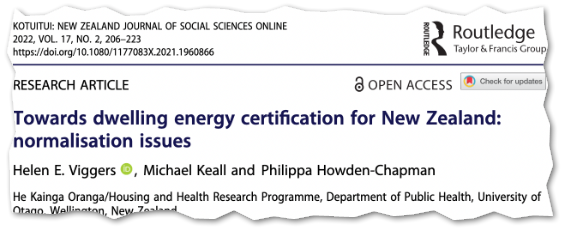Talk of mandatory energy performance certificates (EPC) for New Zealand homes is always guaranteed to spark a lively debate. I admit to still being a bit on the fence on this issue. But the study I discuss below does recommend most of what I’d like to see included, should such a programme be introduced to Aotearoa.
Two things are controversial: (1) would an EPC encourage better-performing, healthier housing and if so, (2) what form should it take? Building scientists working in other countries with EPC labels on buildings have told me that EPC energy models are simplified and crude, in order to keep the costs down. As a result, the rating does not accurately reflect the building energy use. If the EPC isn’t accurate*, why bother doing it? This is a hard argument to counter.
There’s been a very useful contribution to this debate from leading researchers at He Kāinga Oranga, the Housing and Health Research Programme at the University of Otago. Helen Viggers et al review the form of energy certification used by similar countries and discuss the potential impact of applying the various forms to New Zealand dwellings in their paper, “Energy performance certificates for NZ homes”.
The researchers took a sample of 85 buildings and ranked them using nine different methods used in different EPC programmes around the world. The surprising finding is none were consistently ranked across all the normalisation methods. The variance was so profound that only one dwelling was ranked in the ‘better’ half of the data for every method. Clearly the different certification schemes are measuring different attributes.
The authors note that some of the forms of normalisation systematically advantage large dwellings, while others favour small dwellings. The point of their paper is that value judgements underpin the development of criteria for energy certification programmes and an explicit conversation needs to happen right at the outset about what we value with regard to energy efficiency. The choice of metrics is not neutral, it is inherently values-based.
For instance, automatically dividing energy use by some definition of useful or gross floor area does not produce an inherently fair metric. A large home has its energy use divided by a much larger number (floor area) compared to a tiny home so appears more efficient on that basis, even though the two dwellings might in fact house the same number of people. The performance would be very different if the energy use were divided by number of occupants. (Although how to account for the sometimes large gap between theoretical occupancy vs actual occupancy? Consider a 300m2 home with four bedrooms that is occupied by two people apart from one week over Christmas when there are eight or 10 people staying.)
Another complicating factor is that small buildings inherently are not as energy efficient because of their higher surface area to volume ratio: they lose more heat on a per square meter of floor area basis compared to a larger building. See the researcher’s graph below, note this is measuring energy loss not demand and it’s divided by floor area. As the building gets larger, heat losses reduce. This is why it’s easier and cheaper for apartment blocks, row houses and even duplexes to reach the Passive House standard compared to a detached single-family home.

Graph from Energy performance certificates for NZ homes, Viggers et al
The modelling in the Otago paper is very simplified but nevertheless revealing. Here’s another figure where the red circles show how the heating energy losses increase with house size, as surface area increases.

Graph from Energy performance certificates for NZ homes, Viggers et al
NZ building energy performance certificates
Which size home is better, a larger one or a smaller one? The answer depends on what you value! What if we looked at heat loss per person? That would produce very different results.
Whichever metric is used to predict energy consumption, I think it’s vital to include a proper estimate of the error bars or accuracy of that prediction. For some simplified techniques that I think over-simplify site shading, the error bars would be huge, in the order of +/-30%. For an improved model with some airtightness testing and construction quality control, it might be +/-10%.
The report’s final recommendation was to include several metrics and allow the certificate to be updated for cost/CO2 metrics without requiring the thermal modeling to be redone. (This means that as costs or grid CO2 values change over time, the certificates are easy to update.)
The authors support the introduction of an energy certification programme in New Zealand. They say: “We suggest that the final public-facing certificate include the total amount of energy estimated to be required to condition the dwelling to the standard temperature regimen, along with five related figures:
- an estimated annual cost of conditioning the dwelling to that regimen;
- the estimated total annual CO2 emissions generated by conditioning the dwelling to that regimen;
- the total amount of energy required for conditioning to the regimen per potential occupant;
- the total amount of external energy required to condition to that regimen per adjusted square metre (using the Australian method of adjusting for both dwelling size and form), and
- a dwelling surface area averaged construction R-value.
The number of potential inhabitants could be determined by assuming 2 people per bedroom over 10 sqm, and 1 person per bedroom between 6 and 10 sqm, along with 1 living room and habitable rooms defined as per the 1947 regulations.” [note numbering, formatting and emphasis mine]
Because I’m an engineer, I’d also ideally want to define the standard temperature regimen to include the pre-bound effects and how to estimate the coefficient of performance for the heating/cooling system etc. The devil, and the value of an energy certificate programme, is all in the details.
*Certainly the outcome would be inaccurate if a New Zealand EPC used energy modelling similar to the current H1 energy VM1 verification method. H1 is designed for verification (does X meet the standard? Tick Y/N) not predictive modelling. An absolute baseline for any EPC is not misleading people.
Source
Viggers, Helen, Keall, Michael & Howden-Chapman, Philippa. (2021). Towards dwelling energy certification for New Zealand: normalisation issues. Kōtuitui: New Zealand Journal of Social Sciences Online. 17. 1-18. 10.1080/1177083X.2021.1960866.
https://doi.org/10.1080/1177083X.2021.1960866
Abstract
With the impact of climate change, the use of both energy and resources that lock in future energy use is receiving heightened attention. New Zealand has lagged behind many similar countries in not requiring an explicit energy certification for dwellings. This paper reviews the form of energy certification used by similar countries and discusses the potential impact of applying the various forms to New Zealand dwellings.
Specifically, it compares how different forms of comparison, or normalisation, value the features of a home and implicitly rate which dwellings are considered ‘like’ each other. Of the 85 buildings compared, none received consistent rankings across all the normalisation methods and only one was in the ‘better’ half of the data under all nine of the normalisation methods used. Some of the forms of normalisation systematically advantaged large dwellings, and others small dwellings.
Since normalisation methods can be chosen to value certain aspects of dwelling design, there needs to be a discussion about what we value in dwellings in order to determine which method(/s) would be appropriate for New Zealand. The main purpose of this paper is to alert social scientists of the need to have this value-based discussion.
